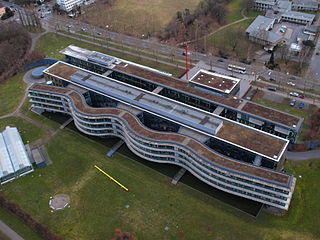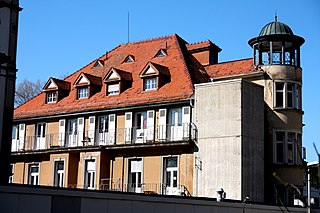Computational neuroscience is a branch of neuroscience which employs mathematics, computer science, theoretical analysis and abstractions of the brain to understand the principles that govern the development, structure, physiology and cognitive abilities of the nervous system.
The following outline is provided as an overview of and topical guide to neuroscience:
Terrence Joseph Sejnowski is the Francis Crick Professor at the Salk Institute for Biological Studies where he directs the Computational Neurobiology Laboratory and is the director of the Crick-Jacobs center for theoretical and computational biology. He has performed pioneering research in neural networks and computational neuroscience.

Max Planck Institute for Neurobiology of Behavior – caesar in Bonn is a non-university research institute of the Max Planck Society. It was founded on 1 January 2022. The institute had been associated with the Max Planck Society since 2006, known as the Center of Advanced European Studies and Research (caesar) and has had its focus on neurosciences since this time.
Neurophilosophy or the philosophy of neuroscience is the interdisciplinary study of neuroscience and philosophy that explores the relevance of neuroscientific studies to the arguments traditionally categorized as philosophy of mind. The philosophy of neuroscience attempts to clarify neuroscientific methods and results using the conceptual rigor and methods of philosophy of science.
The Krasnow Institute for Advanced Study brings together researchers from many disciplines to study the phenomenon known as the mind. A unit of George Mason University, the Krasnow Institute also serves as a center for doctoral education in neuroscience. Research at the institute is funded by agencies such as the National Institutes of Health, the National Science Foundation and the Department of Defense.
Neuroinformatics is the emergent field that combines informatics and neuroscience. Neuroinformatics is related with neuroscience data and information processing by artificial neural networks. There are three main directions where neuroinformatics has to be applied:

The International Neuroinformatics Coordinating Facility is an international non-profit organization with the mission to develop, evaluate, and endorse standards and best practices that embrace the principles of Open, FAIR, and Citable neuroscience. INCF also provides training on how standards and best practices facilitate reproducibility and enables the publishing of the entirety of research output, including data and code. INCF was established in 2005 by recommendations of the Global Science Forum working group of the OECD. The INCF is hosted by the Karolinska Institutet in Stockholm, Sweden. The INCF network comprises institutions, organizations, companies, and individuals active in neuroinformatics, neuroscience, data science, technology, and science policy and publishing. The Network is organized in governing bodies and working groups which coordinate various categories of global neuroinformatics activities that guide and oversee the development and endorsement of standards and best practices, as well as provide training on how standards and best practices facilitate reproducibility and enables the publishing of the entirety of research output, including data and code. The current Directors are Mathew Abrams and Helena Ledmyr, and the Governing Board Chair is Maryann Martone
The Interdisciplinary Center for Neural Computation is a research center of the Hebrew University. It was established in 1992 to provide an inter-face for interactive research in Neurobiology, Physics and Applied Physics Computer Science and Psychophysics with the objective of increasing the understanding of how the brain works with specific focus on computational aspects of the nervous system. The center has facilities for studying and modeling the nervous system at its different levels, from single neuron computation to signal processing in small and large cortical networks, to the system and the behavioral level. This is backed up by 26 faculty members.
In the field of computational neuroscience, brain simulation is the concept of creating a functioning computer model of a brain or part of a brain. Brain simulation projects intend to contribute to a complete understanding of the brain, and eventually also assist the process of treating and diagnosing brain diseases. Simulations utilize mathematical models of biological neurons, such as the hodgkin-huxley model, to simulate the behavior of neurons, or other cells within the brain.
Neurosecurity has been defined as "a version of computer science security principles and methods applied to neural engineering", or more fully, as "the protection of the confidentiality, integrity, and availability of neural devices from malicious parties with the goal of preserving the safety of a person’s neural mechanisms, neural computation, and free will". Simply put, Neurosecurity is, at least in principle, an antivirus and firewall for the mind. Neurosecurity also refers to the application of neuroscience to behavioral information security to better understand and improve users' security behaviors. Neurosecurity is a distinct concept from neuroethics; neurosecurity is effectively a way of enforcing a set of neuroethical principles for a neural device. Neurosecurity is also distinct from the application of neuroscience to national security, a topic that is addressed in Mind Wars: Brain Research and National Defense by Jonathan D. Moreno.
Informatics is the study of computational systems. According to the ACM Europe Council and Informatics Europe, informatics is synonymous with computer science and computing as a profession, in which the central notion is transformation of information. In some cases, the term "informatics" may also be used with different meanings, e.g. in the context of social computing, or in context of library science.
The Computation and Neural Systems (CNS) program was established at the California Institute of Technology in 1986 with the goal of training PhD students interested in exploring the relationship between the structure of neuron-like circuits/networks and the computations performed in such systems, whether natural or synthetic. The program was designed to foster the exchange of ideas and collaboration among engineers, neuroscientists, and theoreticians.

The Center for Neurotechnology (CNT) is an Engineering Research Center funded by the National Science Foundation, develops devices to restore the body's capabilities for sensation and movement. The center is based at the University of Washington. Its core partner organizations are the Massachusetts Institute of Technology and San Diego State University.

NEST is a simulation software for spiking neural network models, including large-scale neuronal networks. NEST was initially developed by Markus Diesmann and Marc-Oliver Gewaltig and is now developed and maintained by the NEST Initiative.

The Bernstein Center Freiburg (BCF) is the central facility for experimental and theoretical research in the areas of computational neuroscience and neurotechnology at the University of Freiburg. As a member of the national network for computational neuroscience (NNCN), founded by the Federal Ministry of Education and Research (BMBF) in 2004, the BCF is one of a total of six Bernstein Centers in Germany. Like the other Bernstein Centers, it was named after the German physiologist Julius Bernstein. The BCF is located in the former Institute of Brain Research ("Neurophys") in Freiburg-Herdern. Initially known as Bernstein Center for Computational Neuroscience Freiburg (BCCN), the institute was renamed Bernstein Center Freiburg in 2010. The coordination site for the national Bernstein Network resides in the building of the Bernstein Center Freiburg.
Sean Lewis Hill is an American neuroscientist, Professor at the University of Toronto Faculty of Medicine, and co-founder and CEO of Senscience, an AI startup dedicated to transforming science with open data. He was previously the Inaugural Scientific Director of the Krembil Centre for Neuroinformatics in Toronto, Canada. He is also co-director of the Blue Brain Project at the École Polytechnique Fédérale de Lausanne located on the Campus Biotech in Geneva, Switzerland. Hill is known for the development of large-scale computational models of brain circuitry, neuroinformatics, and innovation in AI for mental health.
Viktor K. Jirsa is a German physicist and neuroscientist, director of research at the Centre national de la recherche scientifique (CNRS), director of the Institut de Neuroscience des Systèmes and co-director of the Fédération Hospitalo-Universitaire (FHU) EPINEXT "Epilepsy and Disorders of Neuronal Excitability" in Marseille, France. He is workpackage leader in the Epinov project funded in the context of the RHU3 call and coordinated by Fabrice Bartolomei.
The Werner Reichardt Centre for Integrative Neuroscience (CIN) is the common platform for systems neuroscience at the University of Tübingen in Germany. It was installed as a cluster of excellence within the framework of the Excellence Initiative in 2007/2008. About 90 scientists with their research groups – 21 of which are supported with excellence initiative funds – form the CIN's membership. The focus of their work is on basic research in systems neurobiology. Based on an interdisciplinary and integrative approach, it encompasses projects rooted in biology, medicine, physics, computer science and engineering, as well as cognition and neurophilosophy.
Tatjana Tchumatchenko is a physicist in the field of theoretical neuroscience. She is an independent Max Planck Group Leader and, since November 2020, professor for Computational Neuroscience of Behavior at the Faculty of Medicine of the Rheinische Friedrich-Wilhelms-Universität Bonn (Germany). In her research she investigates how neural networks compute and how particular activity patterns emerge from synaptic and neuronal features.




